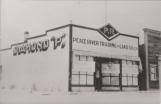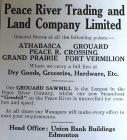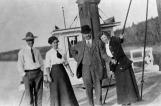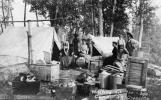1
By 1911 there was tremendous interest in the Peace River region of northern Alberta and British Columbia and the number of individuals coming to settle there was increasing rapidly. This increase in settlement and the promise of much more to come prompted a group of investors led by Percy Machell and Fred Lawrence to establish the Peace River Trading and Land Company. At the time of its creation the Company was to have several areas of operation: the encouragement of settlement in the Peace River region; the opening of a series of retail stores (known as the Diamond "P") to serve the newcomers; a sawmill in Grouard to supply lumber needs; and the operation of a steamboat on the Peace River. While the Company failed in its plans for large scale "colonization" of the Peace River area it quickly made good on its retail and transportation plans.Note:
Relatively little has been written about the Peace River Trading and Land Company. The most detailed discussion of the Company's activities can be found in David W. Leonard. The Last Great West: The Agricultural Settlement of the Peace River Country to 1914.
2
The Diamond "P" store in Peace River Crossing.Circa 1912-1914
Peace River Crossing, Alberta, Canada
 Credits:
Credits:Peace River Museum, Archives & Mackenzie Centre, 77.799.007
3
As noted in its advertisements the Peace River Trading and Land Company opened a series of Diamond "P" stores in Fort Vermilion, Peace River, Athabasca Landing, Grouard, and Grande Prairie.4
Peace River Trading and Land Company.Circa 1912-1914
 Credits:
Credits:Alberta Historic Sites, Reference Collection.
5
The Company's vision of providing water transportation on the Peace River took the form of the steamboat S.S. Grenfell. It was to be built in the West Peace River boatyards at Peace River Crossing by George Magar who was to stay on as Captain after the boat's launch in the spring of 1912. The Grenfell was a sternwheeler designed to carry both freight and passengers and travelled the Peace River from Fort Vermilion to Hudson's Hope. Its main competition was the S.S. Peace River, operated by the Hudson's Bay Company.6
Passengers loading a reluctant cow onto the S.S. Grenfell.Circa 1912-4
Peace River Crossing, Alberta, Canada
 Credits:
Credits:Peace River Museum, Archives & Mackenzie Centre, 81.1194.089
7
Wood is being gathered as fuel for the S.S. Grenfell.Circa 1912-4
Peace River Crossing, Alberta, Canada
 Credits:
Credits:Peace River Museum, Archives & Mackenzie Centre, 81.1194.097
8
Passengers on the top deck of the S.S. Grenfell.Circa 1914
Peace River Crossing, Alberta, Canada
 Credits:
Credits:Peace River Museum, Archives & Mackenzie Centre, 80.1130.018
9
The S.S. Grenfell was to enjoy only three seasons on the Peace River. The end of its operation on the river was described on the front page of the Peace River Record (a local newspaper published at Peace River Crossing) for September 19th, 1914:"On Saturday last [September 12th], while the crew were engaged in returning freight to St. John's, the S.S. Grenfell, which was grounded on a sand bar 15 miles above St. John's, suddenly became afire, and as there was no steam on and only two men on board, the boat was soon a complete mass of flames and nothing whatever was saved from the wreck. The fire is supposed to have started from the galley range. The S.S. Grenfell was built in the spring of 1912 and was owned by the Peace River Trading & Land Co. Captain Forrest and crew arrived in one of the life boats on Thursday last."
Source: Peace River Record, September 19th, 1914, Vol. 1, Number 9.
10
The S.S. Grenfell on the Peace River.Circa 1914
Peace River Crossing, Alberta, Canada
 Credits:
Credits:Peace River Museum, Archives & Mackenzie Centre, 80.1130.017
11
With the destruction of the Grenfell in 1914 the Peace River Trading & Land Company was dissolved. The Company's vision of operating steamboats on the Peace River was ended.12
A group of people waiting for the S.S. Grenfell at Peace River Crossing.Circa 1912-4
Peace River Crossing, Alberta, Canada
 Credits:
Credits:Peace River Museum, Archives & Mackenzie Centre, 81.1194.088